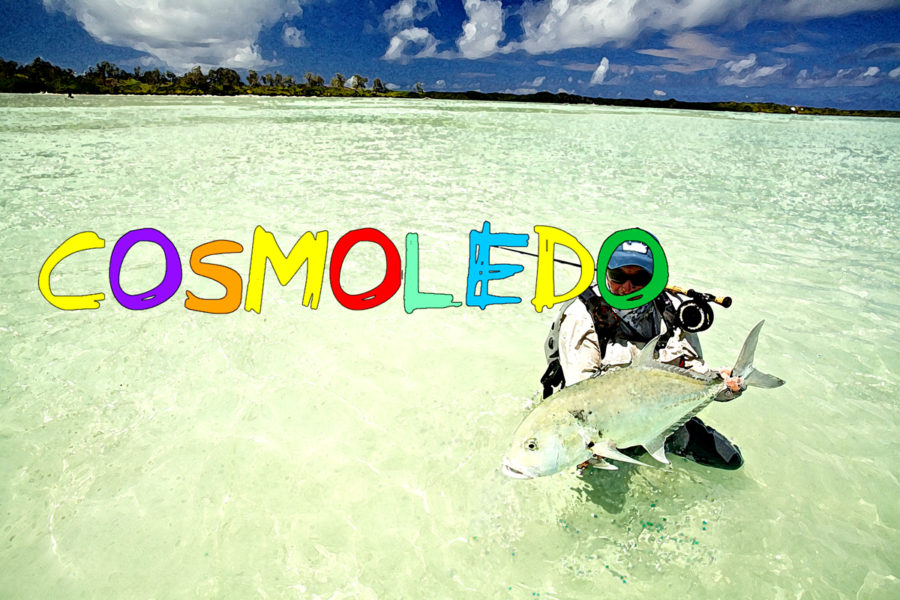By: Ueli Zellweger
(Originally published in Tail Issue 30, July 2017)
Way out in the Indian Ocean, roughly 1000km to the Southwest of the main Seychelles Islands and some 500km up from Madagascar lies the Aldabra Coral Island group. Aldabra is a magnificent place and a World Heritage Site; next door is Cosmoledo with Astove and Assumption completing this group of islands. Apart from a small, newly built fly fishing lodge operated by Alphonse Fishing Company, all of the islands are uninhabited. They boast fantastic scenery, clear waters, spectacular wildlife and some of the best fly fishing on earth.
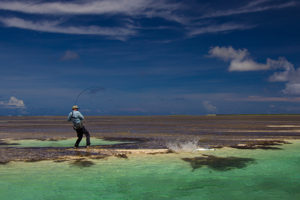
Cosmoledo, an island of volcanic origin, is slightly rectangular in shape and has a 10–14 km wide lagoon that is fringed by about 10 larger coral islands with some funky coral heads in between.It is in pristine condition and is mainly filled and drained by one massive channel. The tides can vary from 0.2 to 2.4m, so huge water volumes can flow in and out multiple times each day. There are endless white sand flats interspersed with turtle grass patches and easily wadeable coral grounds. The variety of fish species is extraordinary, and Cosmoledo is well-known for big surprises. It is well managed for conservation; fly fishing is limited to eight rods per week and only happens for four to five weeks in late autumn and nine to 10 weeks in early spring. Further contributing to the pristine conditions is the fact that there isn’t any commercial fishing for hundreds of miles. Soon after my first visit in 2003, all of the outer atolls of the Seychelles were closed due to the threat from Somali pirates. They were reopened in 2014, as there had not been any piracy issues for over seven years. The combination of phenomenal giant trevally fly fishing with the remoteness, natural beauty and diverse wildlife always makes Cosmoledo a memorable and world-class experience, which is why I’ve been back a number of times.
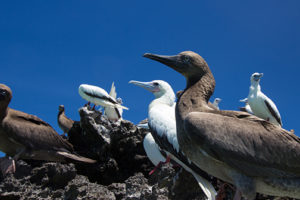
To get to Astove, we took a three-hour flight in a dual prop engine 12-seater from Mahé, the main island, with a quick pit stop for refueling on Alphonse. After landing on the grass strip of Astove, our group was swiftly moved across the island to board the magnificent catamaran, Lone Star, which we would stay on for the week of our trip. The head guide and the captain used the smooth, three-hour sail from Astove to Cosmoledo to brief us on plans and expectations for the trip. The daily routine began the next morning with a hearty breakfast and fishing beginning at 8 am. Given the challenging tides and wind directions, proper planning is crucial to approach spots in the appropriate way to target a variety of fish: primarily GTs, bonefish, milkfish, triggerfish and permit. GTs rule the area, and there is an abundance of them sitting on the rays gliding over the flats, patrolling the beaches in smaller groups or feeding in the roaring surf out near a reef. The first day started out with a big bang for me. Our guide took us ashore where we patrolled the beautiful sandy beach for a mile. Under the blue sky, the air was clear, and we had an unhindered view of a medium surf. We could not see any fish, but at one point my partner started to blindly cast with his 12-weight and bushy fly. He soon hooked a big fish but quickly lost it when his line got tangled. After the hook up, I headed another few hundred yards to a coral head where I had noticed a slight cross current. On my second cast, I hooked and landed my first GT, and then three casts later I had an even bigger fish. In the hour at that spot, I caught three GTs and a trophy Bluefin Trevally. It was the perfect way to start the trip.
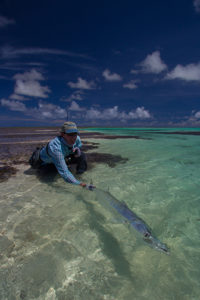 Another trip highlight came on day four when the youngish Seychellois, Alex, was my guide. He had mixed up tides on the previous day, and his skiff got stuck on a sandy flat as he returned from the surf with his two guests. We had to postpone dinner because of his mishap, and the guests and fellow guides punished him with some extra drinks. On our day together, he got revenge on his fellow guides by helping me catch a grand slam on the flats, and the following day he guided two lucky guests to a double slam with milkfish. On my grand slam day, the six-pound bonefish was the first and easiest catch. The first GT was sitting on a ray, and I managed to hook and safely land it with my 8-weight on a bonefish fly. Alex shook his head and mentioned that he had never seen a GT landed on an 8-weight before. After another GT on my 11-weight, we headed out to find a trigger. It took us a while, until I saw one in a seemingly impossible spot, tailing hard in a huge patch of deep and dense turtle grass. We maneuvered quietly towards it, and the first cast was about one meter off due to the light breeze, but the second cast landed where I wanted it. The fish noticed my fly on the second twitch, followed it for a tense half yard and then took it. I quickly set the hook, and three minutes later I was over the moon after officially completing my first grand slam ever.
Another trip highlight came on day four when the youngish Seychellois, Alex, was my guide. He had mixed up tides on the previous day, and his skiff got stuck on a sandy flat as he returned from the surf with his two guests. We had to postpone dinner because of his mishap, and the guests and fellow guides punished him with some extra drinks. On our day together, he got revenge on his fellow guides by helping me catch a grand slam on the flats, and the following day he guided two lucky guests to a double slam with milkfish. On my grand slam day, the six-pound bonefish was the first and easiest catch. The first GT was sitting on a ray, and I managed to hook and safely land it with my 8-weight on a bonefish fly. Alex shook his head and mentioned that he had never seen a GT landed on an 8-weight before. After another GT on my 11-weight, we headed out to find a trigger. It took us a while, until I saw one in a seemingly impossible spot, tailing hard in a huge patch of deep and dense turtle grass. We maneuvered quietly towards it, and the first cast was about one meter off due to the light breeze, but the second cast landed where I wanted it. The fish noticed my fly on the second twitch, followed it for a tense half yard and then took it. I quickly set the hook, and three minutes later I was over the moon after officially completing my first grand slam ever.
The tally for the week across all eight anglers was a respectable 98 GTs, two milkfish, 10 triggers, a large dogtooth tuna, many bluefins and bonefish plus numerous other species like jobfish, groupers, and snappers. The biggest GT was caught offshore and measured 124cm! We wrecked five rods and lost many fly lines to the tough terrain and fish. The weather did not always cooperate, with afternoon high clouds and the occasional torrential tropical downpour. In a really good week, Cosmoledo often delivers 200 or more GTs. The bonefishing was relatively slow on this trip (the ones we saw were large and reached up to nine pounds), while I counted at least 500 milkfish on the flats alone.
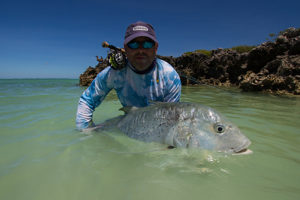 In addition to the remarkable scenery and fishing, the wildlife is spectacular, and it is quite common that there are up to 20 green and hawksbill turtles feeding next to you. And on some of the islands, there are many bird colonies roosting or breeding. Most of the birds are boobies, but there are also greater frigates, and I even saw a pair of the very rare red-tailed tropicbird. These birds are not shy, and sometimes greater frigates will chase a booby until it regurgitates its fish so that the frigate can eat it. This part of the world is magical and provides the fishing trip of a lifetime. You won’t regret going, and you will most certainly want to return.
In addition to the remarkable scenery and fishing, the wildlife is spectacular, and it is quite common that there are up to 20 green and hawksbill turtles feeding next to you. And on some of the islands, there are many bird colonies roosting or breeding. Most of the birds are boobies, but there are also greater frigates, and I even saw a pair of the very rare red-tailed tropicbird. These birds are not shy, and sometimes greater frigates will chase a booby until it regurgitates its fish so that the frigate can eat it. This part of the world is magical and provides the fishing trip of a lifetime. You won’t regret going, and you will most certainly want to return.

